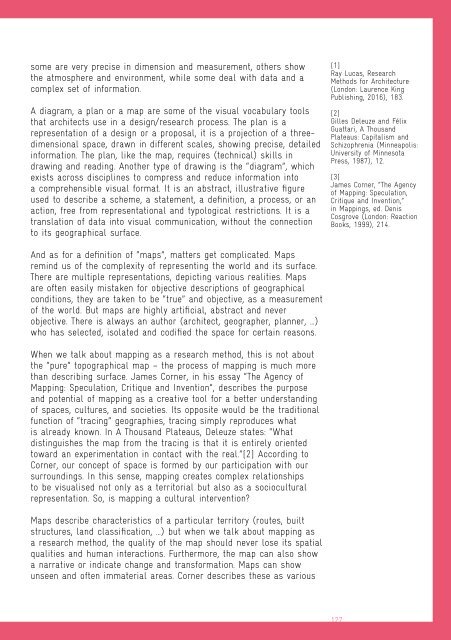Mapping the Croatian Coast
ISBN 978-3-86859-648-9
ISBN 978-3-86859-648-9
You also want an ePaper? Increase the reach of your titles
YUMPU automatically turns print PDFs into web optimized ePapers that Google loves.
some are very precise in dimension and measurement, o<strong>the</strong>rs show<br />
<strong>the</strong> atmosphere and environment, while some deal with data and a<br />
complex set of information.<br />
A diagram, a plan or a map are some of <strong>the</strong> visual vocabulary tools<br />
that architects use in a design/research process. The plan is a<br />
representation of a design or a proposal, it is a projection of a threedimensional<br />
space, drawn in different scales, showing precise, detailed<br />
information. The plan, like <strong>the</strong> map, requires (technical) skills in<br />
drawing and reading. Ano<strong>the</strong>r type of drawing is <strong>the</strong> “diagram”, which<br />
exists across disciplines to compress and reduce information into<br />
a comprehensible visual format. It is an abstract, illustrative figure<br />
used to describe a scheme, a statement, a definition, a process, or an<br />
action, free from representational and typological restrictions. It is a<br />
translation of data into visual communication, without <strong>the</strong> connection<br />
to its geographical surface.<br />
[1]<br />
Ray Lucas, Research<br />
Methods for Architecture<br />
(London: Laurence King<br />
Publishing, 2016), 183.<br />
[2]<br />
Gilles Deleuze and Félix<br />
Guattari, A Thousand<br />
Plateaus: Capitalism and<br />
Schizophrenia (Minneapolis:<br />
University of Minnesota<br />
Press, 1987), 12.<br />
[3]<br />
James Corner, “The Agency<br />
of <strong>Mapping</strong>: Speculation,<br />
Critique and Invention,”<br />
in <strong>Mapping</strong>s, ed. Denis<br />
Cosgrove (London: Reaction<br />
Books, 1999), 214.<br />
And as for a definition of “maps”, matters get complicated. Maps<br />
remind us of <strong>the</strong> complexity of representing <strong>the</strong> world and its surface.<br />
There are multiple representations, depicting various realities. Maps<br />
are often easily mistaken for objective descriptions of geographical<br />
conditions, <strong>the</strong>y are taken to be “true” and objective, as a measurement<br />
of <strong>the</strong> world. But maps are highly artificial, abstract and never<br />
objective. There is always an author (architect, geographer, planner, …)<br />
who has selected, isolated and codified <strong>the</strong> space for certain reasons.<br />
When we talk about mapping as a research method, this is not about<br />
<strong>the</strong> “pure” topographical map – <strong>the</strong> process of mapping is much more<br />
than describing surface. James Corner, in his essay “The Agency of<br />
<strong>Mapping</strong>: Speculation, Critique and Invention”, describes <strong>the</strong> purpose<br />
and potential of mapping as a creative tool for a better understanding<br />
of spaces, cultures, and societies. Its opposite would be <strong>the</strong> traditional<br />
function of “tracing” geographies, tracing simply reproduces what<br />
is already known. In A Thousand Plateaus, Deleuze states: “What<br />
distinguishes <strong>the</strong> map from <strong>the</strong> tracing is that it is entirely oriented<br />
toward an experimentation in contact with <strong>the</strong> real.”[2] According to<br />
Corner, our concept of space is formed by our participation with our<br />
surroundings. In this sense, mapping creates complex relationships<br />
to be visualised not only as a territorial but also as a sociocultural<br />
representation. So, is mapping a cultural intervention?<br />
Maps describe characteristics of a particular territory (routes, built<br />
structures, land classification, …) but when we talk about mapping as<br />
a research method, <strong>the</strong> quality of <strong>the</strong> map should never lose its spatial<br />
qualities and human interactions. Fur<strong>the</strong>rmore, <strong>the</strong> map can also show<br />
a narrative or indicate change and transformation. Maps can show<br />
unseen and often immaterial areas. Corner describes <strong>the</strong>se as various<br />
127


















